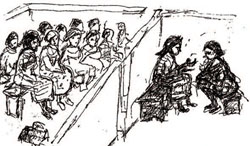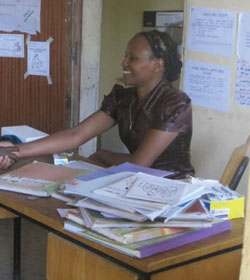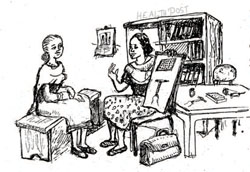Use 'Print preview' to check the number of pages and printer settings.
Print functionality varies between browsers.
Printable page generated Friday, 21 November 2025, 5:50 AM
Adolescent and Youth Reproductive Health Module: 9. Counselling Young People
Study Session 9 Counselling Young People
Introduction
Clear and effective communication is basic in helping young people to achieve healthy sexual and reproductive lives. In this session you will learn how you can establish good relationships with young people to enable effective counselling on sexual and reproductive health issues to take place. The basic principles of communication and counselling are taught in the Health Education, Advocacy and Community Mobilisation Module. Also the Family Planning Module has a study session on counselling for family planning. However, this study session will focus on the particular circumstances and needs of young people. Understanding the young person’s perspective on sexual issues will enable you to respond appropriately in discussions. Having a good relationship with your young clients will make them feel more relaxed and able to talk about their sexual and reproductive health problems. This in turn will enable you to effectively counsel and serve the needs of the young.
Learning Outcomes for Study Session 9
When you have studied this session, you should be able to:
9.1 Define and use correctly all of the key words printed in bold. (SAQ 9.1)
9.2 Describe ways to establish trust with young people. (SAQs 9.1, 9.2 and 9.3)
9.3 Identify behaviours conducive to counselling young people. (SAQs 9.1, 9.2 and 9.3)
9.4 Describe good counselling techniques to be used with young people. (SAQs 9.1, 9.2 and 9.3)
9.1 The purpose of counselling young people
The purpose of counselling young people on reproductive health issues is to help them to:
- Make rational decisions
- Cope with their existing situation.
The more a young person can be made comfortable, the more likely they are to express their sexual and reproductive health problems. This enables you to effectively counsel and serve them so that they can achieve control over their own behaviour, understand themselves, anticipate the consequences of their actions, and making long-term plans.
In counselling there are two actors: you the counsellor and the young person. Your behaviour as well as the characteristics of the young person can affect the counselling process. Counselling is a person-to-person, two-way communication during which you:
- Provide adequate information to help the young person make an informed decision
- Help the young person evaluate their feelings and opinions regarding the problem for which help was sought
- Act as emotional support for them.
Counselling is not:
- A method of providing solutions to the young person’s problems
- A method of giving instructions
- The promotion of a life plan that has been successful for you.
9.2 General principles of counselling
Adolescents are going through dramatic biological and psychological changes, as described in Study Session 1 of this Module, and, as a result of these changes, seeking healthcare may be challenging and difficult for them. In the first instance you need to remember and apply the general principles and concepts of counselling before thinking of the additional considerations required to meet the needs of this special group.
Stop reading for a moment and think about the general guidelines for effective counselling.
What are the general principles that you should follow for a successful outcome to a counselling session?
These are the important principles and conditions necessary for effective counselling:
- Privacy. You need to find a quiet place to talk where you cannot be seen or overheard and where the interaction is free from interruptions.
- Confidentiality. You need to make it clear that you will not tell other people about the discussions you have with your client.
- Respect. You need to conduct the discussion in a helpful atmosphere. You should show respect for your client and be non-judgemental.
- Time. You need to allow sufficient time so that the client can relax and feel confidence in you.
- Keep it simple-use words the young person will understand.
- First things first. Do not cause confusion by giving too much information.
- Say it again. Repeat the most important instructions again and again.
- Use available visual aids like posters and flipcharts.

You need to remember these guidelines when you are counselling young people about sexual and reproductive health matters, but there are additional considerations because these are particularly sensitive issues for them. The first three points on the list above need special attention. The young person will not feel comfortable talking with you if they think their conversation can be overheard (Figure 9.1) or if they think you might discuss their personal matters with someone else. If, in some circumstances, you believe it is necessary to share information with others (for example, to prevent further sexual abuse), you should explain why it is important and when, how, and with whom the information will be shared.
Many young people are unsure of themselves and lack confidence in their own ability. They will warm to you if you show them respect and demonstrate that you regard them as capable of making good decisions. Respect also assumes that the young person can be different and have varying needs that are legitimate and deserve a professional response. To be in the best position to help them you need to understand their feelings and the changes they are going through.
9.3 Establishing trust with young people
9.3.1 Feelings of the young

If you can understand the feelings of your young client and appreciate their needs, you will be in a good position to answer questions and help with anxieties that they may have concerning their sexual and reproductive health.
How might a young person feel when they first come to see you?
Figure 9.2 shows a young girl outside a health post, hesitating to enter. She might be feeling:
- Shy about needing to discuss personal matters.
- Embarrassed that she is seeking sexual or reproductive healthcare.
- Worried that someone she knows might see her and tell her parents.
- Unsure that she has the right words to describe what is concerning her and ill-informed about reproductive health matters in general.
- Anxious that she has a serious condition that will have significant consequences (e.g. that she has a sexually transmitted infection (STI) or that she is pregnant).
- Resistant to receiving help because of overall rebelliousness, discomfort or fear.
These points apply equally to a boy or young man who comes to see you.
9.3.2 Attitudes likely to promote trust
There are a number of things you can do to encourage a young person to trust you in addition to following the general guidelines for effective counselling.
Stop reading for a moment and think about the things you can do to encourage young people to trust you.
Try to understand the way young people feel (Section 9.2.1); remember how you felt in early adolescence (10–14 years of age) and how your feelings and ideas changed as you got older. When you are face to face with a young person, try to:
- be genuinely open to their questions or needs for information
- avoid judgemental words or body language that suggests disapproval of the young person or their questions and needs
- understand that the young person has various feelings of discomfort and uncertainty. Be reassuring in responding to the young person, making them feel more comfortable and confident
- demonstrate sincerity and willingness to help
- reinforce their decision to seek counselling and/or healthcare; do not give them the impression that you think their visit was unnecessary
- exhibit honesty and forthrightness, including an ability to admit when you do not know the answer
- demonstrate responsibility in fulfilling your professional role
- exhibit confidence and professional competence in addressing adolescent and youth reproductive health issues.
9.3.3. Behaviour likely to promote trust: non-verbal communication
Without you realising it, your true feelings can be expressed by your body language or non-verbal communication (Figure 9.3). By this means you can communicate to your young clients the level of interest, attention, warmth and understanding you feel towards them. There are ways that you can take control of your body language and you should remember the acronym ROLES (Box 9.1) when you are communicating with young people. (There is more information on non-verbal communication in the Health Education, Advocacy and Community Mobilisation Module.)

Box 9.1 ROLES
R = Relax the client by using facial expressions that show interest
O = Open up the client by using a warm and caring tone of voice, i.e. help them to talk
L = Lean towards the client, not away from them
E = Establish and maintain eye contact with the client
S = Smile.
9.3.4 Behaviour likely to promote trust: practical arrangements
Here are some practical tips to create a good, friendly first impression.
- Start on time.
- Smile and warmly greet the client.
- Introduce yourself and explain what you do.
It will help to establish rapport during the first session if you:
- face the young person, sitting in similar chairs
- use the young person’s name during the session
- begin the session by allowing the young person to talk freely before you ask questions
- congratulate the young person for seeking help.
Before the session begins, make sure you have printed or other materials that are developmentally and culturally appropriate readily available. There may be opportunities to reinforce health messages from other settings (Figure 9.4) and you may wish to give, some leaflets at the end of the session for the young person to read before they come to see you again.

9.4 Challenges in counselling young people
In previous sections you have learned how your behaviour can affect counselling the young client. Now you will learn how some young people’s behaviours can affect the counselling process. Specifically, we will teach you some of the challenging behaviours that you may face in counselling young people and how you should handle these challenges. They are presented in Box 9.2.
Box 9.2 Counselling challenges
- Silence
- Crying
- Threat of suicide
- Need to talk.
Each of these situations requires appropriate handling.
9.4.1 Silence
This can be a sign of shyness or anxiety. If it occurs at the beginning of a session, you can say, ‘I realise it’s hard for you to talk. This often happens to people who come for the first time.’
If the client is shy, you can legitimise the feeling by saying, ‘I’d feel the same way in your place. I understand that it’s not easy to talk to a person you’ve just met.’
If the young person has difficulty expressing their feelings or ideas, you can use some brochures or posters to encourage discussion or refer to a story so that they can talk about others rather than themselves.
If the young person cannot or will not talk, you should propose another meeting.
9.4.2 Crying
If the young person cries while you are counselling, try to evaluate what provoked the tears and assess if it makes sense in the given situation.
If they are crying to relieve tension, you can give them permission to express their feelings by saying, ‘It’s OK to cry since it’s the normal thing to do when you’re sad.’
If they are using crying as manipulation, you can say, ‘Although I’m sorry you feel sad, it’s good to express your feelings.’
If the crying is consistent with the situation, you should allow them to freely express emotions and not try to stop the feeling or belittle its importance.
9.4.3 Threat of suicide
Attempted suicide is any attempt by the young person to kill themselves. If you believe that a young person has made suicide threats or attempts, you should take it seriously. It is essential that you find out whether they have made any attempts in the past and what reasons they might have had. Consider whether it seems likely that they are really considering suicide now or if it is something that they have said without thinking.
If you are in any doubt it is best to refer the young person to the nearest health facility that provides psychiatric or mental health services. When you decide to refer a young person, make sure that he/she is accompanied to the health facility by somebody from their family.
9.4.4 The need to talk
Challenges in counselling may also include a situation where the young person is very vocal and wants an outlet to express other concerns that may not be directly related to the immediate counselling need as you perceive it.
Give young people the opportunity to express their needs and concerns. If you cannot help them, show that you are listening to the concerns that they are trying to express. When possible, refer them to someone who can help with the problem.
If you cannot help or refer them to someone who can provide assistance, then demonstrate care and concern about the problem. However, be clear that you cannot help.
9.5 Communicating with and counselling young people about sexual issues
Communicating with and counselling young people about sexual issues can be challenging because you are dealing with sensitive topics about which they often feel emotional, defensive and insecure.
Young people must often make significant decisions on the following sexual and/or reproductive health matters:
- How to discourage and prevent unwanted sexual advances.
- Whether or when to engage in sexual relations.
- How to prevent pregnancy and STIs, such as HIV.
- Whether or when to conceive a child.
- Whether to continue or terminate a pregnancy.
- How to deal with sexual abuse and/or violence.
You can work through most of these decisions together if you use good communication and counselling skills. During counselling sessions with young people you need to:
- consider the young person’s age and sexual experience
- demonstrate patience and understanding of the difficulty young people have in talking about sex
- assure privacy and confidentiality
- respect the young person’s feelings, choices, and decisions
- ensure that the young person feels able to ask questions and tell you about their concerns and needs
- respond to expressed needs for information in understandable and honest ways
- explore feelings as well as facts
- encourage the young person to identify possible alternatives
- lead an analytical discussion of the consequences, advantages, and disadvantages of the available options
- assist the young person to make an informed decision
- help the young person to implement their choice.
If you develop and use these approaches, it will foster good decision making by the young people you counsel.
Summary of Study Session 9
In Study Session 9, you have learned that:
- The purpose of counselling is to help young people make rational decisions and cope with the situation they find themselves in. Counselling is a two-way communication process during which you give adequate information and help the young person to evaluate their feelings about their problems. You can also provide emotional support, but you need to understand that counselling is not a method of giving solutions or instructions to the young person.
- In counselling there are two actors: you the counsellor and the young person. The behaviours of both of you and the young person could affect the process of counselling. You need to develop behaviours that allow the young person to relax and feel comfortable with you, then they will also trust you.
- The more a young client can be made comfortable, the more likely they are to express their sexual and reproductive health problems. This enables you to effectively counsel them and serve their needs.
- When a young person is face-to-face with you they may have various feelings which could include shyness, embarrassment, anxiousness, and inadequacy to describe their problems and worries. Understanding their feelings will foster better communication between you.
- Conditions that could encourage trust and a good relationship with the young people include allowing sufficient time for the counselling, showing understanding, honesty and willingness to help them, expressing non-judgemental views and showing confidence and professional competence. These are the behaviours that you need to have and develop to effectively respond to the needs of young people.
- It is good to remember ROLES when counselling young people. ROLES is abbreviation for:
R = Relax the client by using facial expressions that show interest
O = Open up the client by using a warm and caring tone of voice
L = Lean towards the client, not away from them
E = Establish and maintain eye contact with the client
S = Smile.
- Techniques for good counselling include creating a good, friendly first impression, establishing rapport during the first session, and providing simple information in an appropriate way.
- While counselling young people you may face some challenges which require you to respond appropriately. It can be particularly difficult when the young person is silent, cries, threatens suicide or talks at length about issues that you do not perceive to be relevant.
- When you are counselling a young client on sexual and reproductive health issues, use the following approaches: consider their age and sex; be patient; ensure privacy and confidentiality; respond to expressed needs; explore feelings as well as facts; encourage them to identify possible alternatives and then consider the advantages, disadvantages and consequences of these options and assist them to make an informed decision and plan how to implement their choice.
Self-Assessment Questions (SAQs) for Study Session 9
Now that you have completed this study session, you can assess how well you have achieved its Learning Outcomes by answering these questions. Write your answers in your Study Diary and discuss them with your Tutor at the next Study Support Meeting. You can check your answers with the Notes on the Self-Assessment Questions at the end of this Module.
SAQ 9.1 (tests Learning Outcomes 9.1, 9.2, 9.3 and 9.4)
Would you use ROLES if you were counselling a young man who had come to ask you about using condoms? Explain your answer.
Answer
ROLES is the acronym that you can use to remind yourself of good non-verbal techniques to be used in counselling. It is helpful in all situations when you are counselling young people and helps them to see that you are interested in helping them with whatever sexual issue they bring to you. So you would use ROLES when counselling this young man.
SAQ 9.2 (tests Learning Outcomes 9.2 and 9.3)
A 15-year-old girl comes to your health post for help. There are many older women present and you have to see her in front of these other older clients.
- a.Explain whether this girl would be comfortable telling you about her reproductive health problems.
- b.What are the three most important characteristics for creating a comfortable environment for counselling a young person?
Answer
- a.No, this young girl would not be comfortable telling you about her reproductive health problems in front of older clients who might tell her parents.
- b.The three most important characteristics to create a good counselling environment for a young person are to ensure privacy, ensure confidentiality and give respect.
SAQ 9.3 (tests Learning Outcomes 9.2, 9.3 and 9.4)
A 13-year-old girl who thinks she may be pregnant has come to talk to you. She is wondering whether she might also have an STI and is considering whether she might be able to terminate her pregnancy. When discussing these issues with her you have used approaches that foster good communication. You are pleased because this has resulted in a good decision being made. Which of the following approaches would you not have used? Why not?
- a.Respecting her views
- b.Ensuring privacy and confidentiality
- c.Exploring her feelings
- d.Responding to her expressed needs
- e.Making decisions for her.
Answer
You will not have made the decision for her. She must make her own decision. Your role has been to use the other good approaches to establish trust and encourage her to identify possible options. You will then have discussed the advantages, disadvantages and consequences of these options but you will have left her to make her own decision.